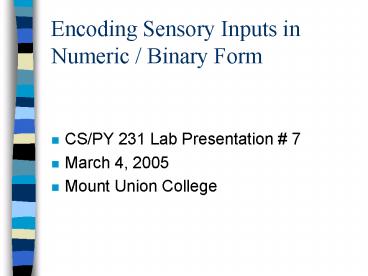Encoding Sensory Inputs in Numeric Binary Form - PowerPoint PPT Presentation
1 / 14
Title:
Encoding Sensory Inputs in Numeric Binary Form
Description:
So far, we have seen networks that can learn to produce numeric output patterns ... the Yankees, White Sox, Red Sox and Orioles as lousy, and all others as mediocre? ... – PowerPoint PPT presentation
Number of Views:45
Avg rating:3.0/5.0
Title: Encoding Sensory Inputs in Numeric Binary Form
1
Encoding Sensory Inputs in Numeric / Binary Form
- CS/PY 231 Lab Presentation 7
- March 4, 2005
- Mount Union College
2
The Problem
- So far, we have seen networks that can learn to
produce numeric output patterns in response to a
sequence of numeric inputs - What do organisms do?
- produce thoughts and behaviors in response to
sensory inputs - We need a way to represent real-world data in
numeric form
3
Example Sequence of Letters
- What if we wanted to train a neural network to
respond to a letter of the alphabet with the
letter that follows the input letter? - e.g., C gt D, U gt V
- Simple task, yet our TLearn networks need to have
numeric data to process - What prior art can we use?
4
Computer Hardware example
- Computer Memory is a collection of a large number
of electronic circuits - Each circuit has two states on or off
- number each state 1 or 0
- A single circuit can represent a 2-valued datum
- yes/no, true/false
- what to do for data items that need more than 2
possible values?
5
Binary s ? Group of Circuits
- Consider two circuits as a single group
- 00 01 10 11
- 2 choices for first bit x 2 choices for second
bit 4 possible values - yes, no, maybe, huh?
- still not enough for letters of the alphabet,
digits, etc.
6
Binary s ? Group of Circuits
- Consider three circuits as a single group
- 000 001 010 011
- 100 101 110 111
- Twice as many possible patterns as with 2 bits
- 2 x 4 8 23
- 4 bits 24 16 patterns 5 bits 25 32
patterns - n bits 2n patterns
7
Example from Lab 6
- We trained a network with 3 inputs and 2 outputs
- Example from Lab 6
- Answer output is the number of zeros in the
input pattern, expressed as a binary number! - But how could you know that? We also need to
decode numeric output into a form that humans can
use.
8
Question for Understanding
- How many binary input and output signals would be
needed to train a network to discriminate thusly
given an American League baseball team, ranking
the Indians as great, the Yankees, White Sox, Red
Sox and Orioles as lousy, and all others as
mediocre? - 14 teams, 3 possible rankings
9
Where does encoding/decoding happen?
- In our computational model, sense organs convert
analog data into digital signals that can be
operated on by a neural network - To model this, we have two options
- Build hardware components that perform this
conversion for us o ( - Convert data into digital form, then present this
to the network o)
10
Where does encoding/decoding happen?
- Output of our model is a bunch of numeric
signals. - We need to convert this into understandable
information - Two approaches
- Build hardware to do the conversion (robot
lab!!!) - Convert data ourselves (either by writing a
program, or doing it manually)
11
Example Diagnosing Illness
- Input parameters
- temperature numeric value
- pulse numeric value
- palpating abdomen hard, squishy, normal
- headache? yes or no
- how many fingers? too few, too many, right
number - Output diagnoses
- ebola, migrane, hypochondria, normal health
12
Example Diagnosing Illness
- Input parameters
- numeric value
- numeric value
- 1 hard, -1 squishy, 0 normal
- 1 headache, 0 no headache
- -1 too few fingers, 1 too many, 0 right
number - Output diagnoses
- some numeric code for each disease
13
Central Problem in Compuational Neural Networks
- Without a correct and proper encoding scheme, the
network wont produce meaningful answers - A large, important part of your term project will
be selecting a data representation for the
problem you choose
14
Encoding Sensory Inputs in Numeric / Binary Form
- CS/PY 231 Lab Presentation 7
- March 4, 2005
- Mount Union College































